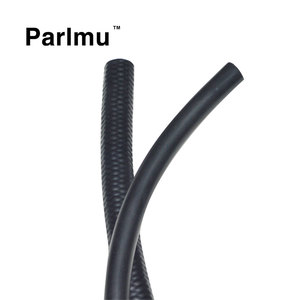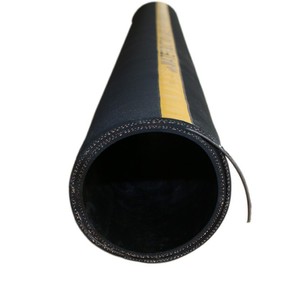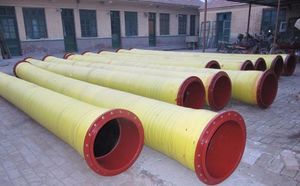(8484 products available)













































































































































































































A nitrile rubber tube contains diverse types. Thus, the resultant feature is distinguished through specific attributes, applications, and benefits. Below are the diverse types:
Standard NBR Rubber Tube
The NBR Rubber Tube is renowned for its excellent resistance to oil, chemicals, and temperature. Frequent uses of these features are found in the automotive industry and machinery sectors. In these cases, oil seals, gaskets, and fuel lines experience this exposure. Standard NBR tubes have impressive durability for strenuous environments.
High-Performance NBR Rubber Tube
A high-performance NBR Rubber Tube is designed for extreme conditions. These include high temperatures and chemical concentrations. Moreover, they are highly regarded in aerospace and heavy industrial applications for their ability to withstand unusually intense adversities.
Heat-Resistant NBR Rubber Tube
The Heat-Resistant NBR Rubber Tube guarantees superior performance in high-temperate environments. These favorable applications include automotive components like radiator hoses and heater lines. Also, they are suitable for machinery in which elevated temperatures are common. In such situations, conventional rubber could degrade.
Oil-Resistant NBR Rubber Tube
The Oil-Resistant NBR Rubber Tube is explicitly formulated to endure oils and petroleum products. The formulation of this resistance is in fuel lines, oil hoses, and hydraulic systems. Further, the long-term performance of these NBR tubing options are in environments that are regularly exposed to oily substances.
Latex Rubber Tubes
These tubes are constructed from natural latex rubber. They offer flexibility and durability when given a moderate stretch. Latex rubber tubing is effective in medical applications. For example, oxygen and intravenous infusion lines. One of their major drawbacks is that many people are allergic to latex. This limits its use in many fields.
Vacuum Rubber Tubing
This tubing is specifically designed to handle negative pressure or vacuum conditions. These conditions can crush or collapse inferior-quality tubing. Its frequent usage is in industrial applications. Examples include suction lines in equipment and medical devices. Its construction includes reinforcement layers for resisting collapse under vacuum pressure.
Multi-Purpose Rubber Tubing
The Multi-Purpose Rubber Tubing is versatile enough for varied applications. These applications include air and water transfer, garden hoses, and general industrial use. They offer moderate chemical and temperature resistance. Thus, making them suitable for various non-specialized environments.
Reinforced Rubber Hose
The Reinforced Rubber Hose is strengthened with fabric or wire mesh. This is meant to take on high-pressure environments. The available pressures can cause disintegration of standard rubber tubes. Commonly, reinforced hoses are used in hydraulic systems, air compressors, and heavy machinery. Therein lies their significance.
A Nitrile Butadiene Rubber (NBR) tube is delineated with diverse features. A good number of these features make it suitable for endless industrial uses. Below are the distinguishing features:
Excellent Oil Resistance
NBR is constructed to demonstrate superior resistance to oils and petroleum-based substances. This is deemed one of the premier features of NBR Rubber Tubes. This characteristic makes them highly valued in automotive and machinery applications. In the said applications, Oil seals, gaskets, fuel lines, and huiles confront exposure to these elements.
Temperature Tolerance
These Rubber Hose Pipes exhibit a wide range of temperature tolerance. This feature is one of NBR's most valuable characteristics. It can handle extreme heat without deforming or losing efficiency. Conventionally, these tubes can maintain structural integrity in temperatures from -40°C to 120°C (-40°F to 248°F). Such a wide tolerance range makes them well-suited for automotive and industrial applications with elevated temperatures.
Durability and Flexibility
NBR Rubber Tube is known for its durability and stretching capabilities. It can break and re-stretch up to a moderate stretch percent. This combination of flexibility and strength ensures that the tubing can effectively transmit fluids. Moreover, it maintains its shape under pressure or mechanical stress.
Chemical Resistance
NBR Rubber Tubes are constructed with good chemical resistance. Thus, they are suitable for a wide variety of industrial applications. Such a mixture of features includes ascertaining exposure of the tubes to acids, fuels, and solvents. These are common features in numerous industrial settings. Therefore, it ascertains that this rubber tubing maintains longevity and reliability.
Cost-Effectiveness
NBR Tubes have gained popularity and are in high demand, especially for their reasonable costs. It offers exceptional performance compared to more expensive materials, such as Ptfe rubber. This premium performance at a lesser price makes it a favorable option for many industries. These industries prefer utilizing it for diverse applications that require oil resistance, chemical durability, and temperature proficiency.
A Nile Butadiene Rubber (NBR) tube has divergent uses. Below are the common applications:
Automotive Industry
A Nbr hose has a diversion of automotive application. These include fuel lines, oil hoses, and other components which regularly confront exposure to oils and fuels. Besides, their excellent oil resistance and temperature proficiency make them indispensable for maintaining safety and reliability in vehicles.
Industrial Applications
NbR rubber tubes are widely used in industrial settings to convey liquids, gases, and chemicals. Reviews say that their durability and chemical retardance ensure they can handle a myriad of substances. This consistently guarantees the transmission process's security and effectiveness.
Machine Components
These rubber tubes are critical in constructing various machine parts. They construct seals, gaskets, and hoses which benefit from NBR's exceptional properties. Such benefits include elasticity and chemical resistance. This makes NBR a favored material for creating components that require flexibility and durability.
Medical Equipment
In medical settings, NBR tubes are used in devices that require reliability and cleanliness. They can come in catheters and other medical lines that confront fluids. Nevertheless, NBR's sterility, flexibility, and durability make it excellent for medical applications.
Construction and Mining
NBR Rubber Tubes are utilized in construction and mining equipment. These include hydraulic systems. These tubes provide exceptional resistance to a variety of fluids. Such fluids include hydraulic oils and fuels. Moreover, their longevity under extreme conditions guarantees reliable performance in harsh environments.
The proper Nitrile Rubber (NBR) tube is selected based on various factors. Below is a guide on the factors to consider:
Application Requirements
Identify the specific needs of the intended application. They should include oil and chemical exposure, temperature ranges, and pressure levels. The identification will help select an NBR tube that meets the needs. The tubes should be proficient in oil and chemical resistance. They are manufactured to withstand mechanical stresses and extreme temperatures.
Customization
In cases where NBR tubes with standard specifications are not suitable, consider reaching out to manufacturers for custom-made solutions. These adaptations include variations in diameter, thickness, and length. Furthermore, additives and reinforcements can be customized for particular applications. Customization allows a tighter fit into applications with rare requirements.
Size and Specification
Measure the required tube diameter and length. They are required for the application. Ensure that the selected NBR tube has the proper wall thickness to withstand the necessary pressures. Proper sizes guarantee compatibility. They ensure the tubes effectively integrate into existing setups.
Oil and Chemical Resistance
Ensure the NBR Rubber Tube possesses the proper level of oil and chemical resistance. It should be in line with the prospective exposure substances. These substances include fuels, oils, and industrial chemicals. Here, assess the manufacturer's data. The data usually contains descriptions of resistance against particular substances. They frequently come in handy in making the right selection.
Durability and Aging
Select a rubber tube that guarantees long-term durability. The longevity of the NBR material will be highly impacted by its aging resistance. Ensure it possesses the capability to maintain efficiency when exposed to UV light, heat, and ozone. These elements tend to degrade inferior materials over time.
Cost and Quality
Consider both the cost and quality of the NBR tubes as these two attributes highly affect their long-term profitability. Never comprise quality for cost. Often, high-quality materials provide better performance and longevity. Weigh the price against the material's prospective benefits to determine its suitability.
Testing and Standards
Ensure the selected NBR Rubber Tubes conform to relevant industry standards. Examples include ISO and SAE. Moreover, consider products that have been subjected to independent testing. Such practices add an extra layer of credibility to the product's specifications.
A1. Normally, NBR Rubber Tubes can proficiently handle temperatures as high as 120°C. This adaptability makes them suitable for assorted applications. They include automotive and industrial usages, where elevated temperatures are characteristically encountered.
A2.Yes, NBR Rubber Tubes are manufactured for medical applications. These tubes benefit from their flexibility, durability, and sterility. Such applications include oxygen and intravenous infusion lines, where reliable and durable tubing is a necessity.
A3.Contrary to latex rubber, NBR does not carry natural allergens. Nonetheless, some formulations may incorporate additives that could cause allergic reactions. Therefore, a checking of product specifications is essential in case of possible allergic reactions.
A4.Normally, both NBR and latex tubes arise with flexibility. However, NBR's durability makes it more fitting for industrial applications. In contrast, latex rubber predominates in medical and lightweight consumer products.
A5. Proper maintenance of NBR tubes is critical to ensure their longevity. Regular cleaning with mild detergents and water is recommended. Additionally, avoid exposing the tubes to harsh chemicals and extreme UV radiation.